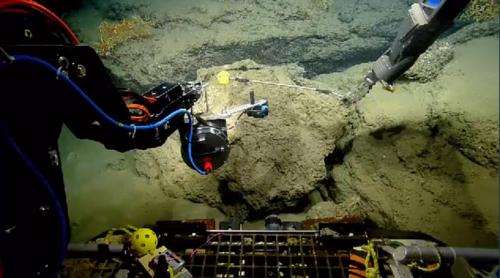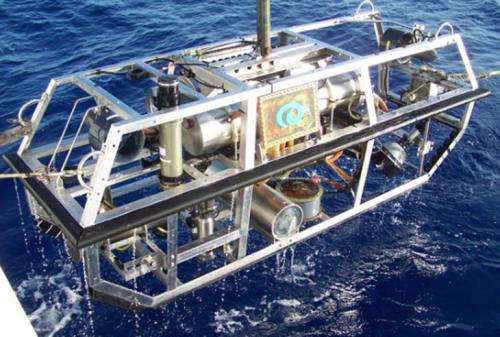Live webcams: Scientists studying corals damaged by oil in the Gulf of Mexico

(Phys.org) —How are the coral communities doing now, four years after they were damaged by the Deep Water Horizon oil spill in the Gulf of Mexico? You can find out by watching live webcams and sending messages to the scientists on a research ship that will be in the Gulf until July 4.
The research expedition is led by Chief Scientist Chuck Fisher, a Penn State University professor of biology. Interact with the research crew, listen in and watch as they explore the ocean floor. The 24/7 live webcams are on the expedition's website, Nautiluslive.org. You also can participate on Facebook and Twitter (@EVNautilus).
"Our mission is to determine the current state of deep-sea coral communities impacted by the Deepwater Horizon Oil spill in 2010, to explore impacts in the communities of animals that live on and around these corals, and to collect samples so we can examine the response of the microbes that live in symbiosis with the corals," Fisher said. "We are taking images of as many of the same corals as possible that we have followed over the last four years, and we also are collecting samples to determine the response of corals and microbes to natural oil seepage."
Under Fisher's leadership on this expedition are Penn State Associate Professor of Biology Iliana Baums and several of their students, as well as researchers from a number of other institutions. They are using the Ocean Exploration Trust vessel Nautilus and the remotely operated vehicle Hercules.

"The Deepwater Horizon Oil Spill was one of the greatest environmental disasters in history," Baums said. "While sailing on the Nautilus, we will continue our efforts to understand its impacts on the deep-water coral populations."
The webcams will connect you with researchers on the ship and let you hear their live commentary about your inquiries and the ongoing research. You also will see live views from the cameras on the remotely operated research vehicle on the ocean floor, in real time. Content is suitable for all ages interested in the deep sea and ocean exploration.
Soon after this expedition ends, you can watch again when Fisher continues on a second leg of the expedition, from July 6 through 10, with a film crew from 60 Minutes and research colleagues from the Max Planck Institute in Bremen, Germany.
In addition to Fisher and Baums, other Penn Staters participating in the current research expedition are Research Technologist Miles Saunders and students Fanny Girard, Jeffrey Mentch and Samuel (Sam) Vohsen.
These expeditions are part of a larger research program focused on examining the ecosystem-level response to oil and gas in the Gulf of Mexico. The research group leading the cruise, Ecosystem Impacts of Oil and Gas Inputs into the Gulf of Mexico (ECOGIG) Consortium, is made up of scientists from a wide variety of disciplines studying current flow, ocean chemistry, microbial activity, deep-sea coral communities and everything in between.
ECOGIG, funded as a part of the Gulf of Mexico Research Initiative (GoMRI), is studying both natural oil and gas seepage into the Gulf of Mexico and ecosystem responses and effects directly attributable to the 2010 Deepwater Horizon oil spill.
Provided by Pennsylvania State University


















